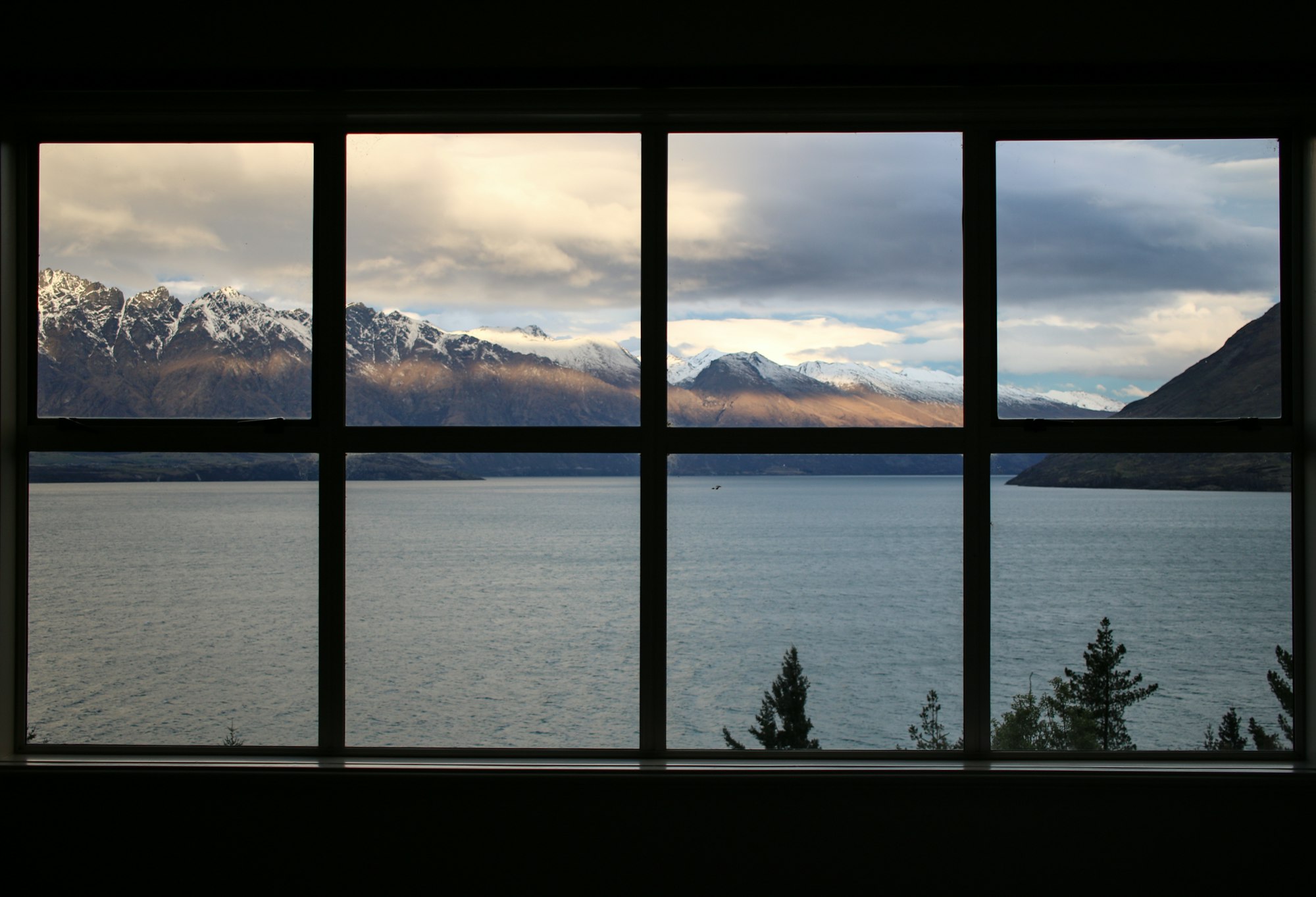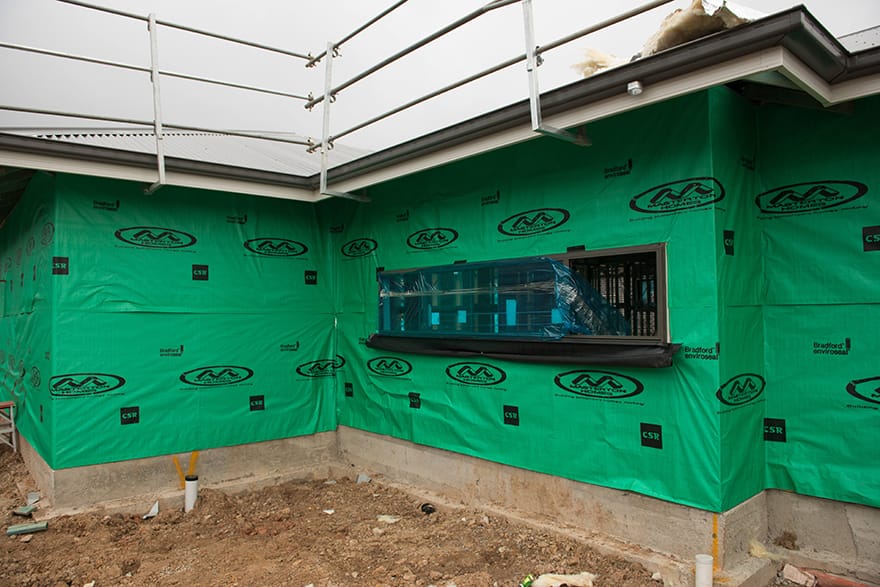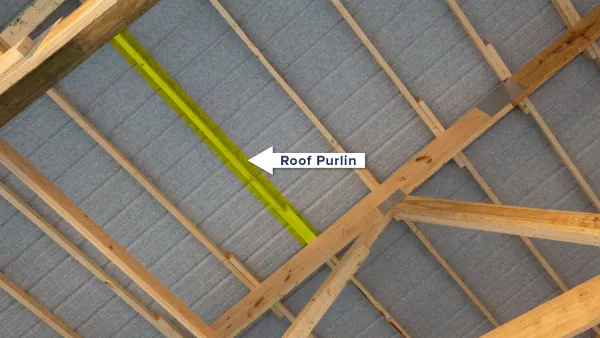Take The Quiz On This Post
Read the post, then take the quiz—test your knowledge and see what you’ve learned!
Introduction
Glazing, which includes windows, external doors with glass, and skylights, plays an major role in determining the comfort, energy efficiency, and overall performance of your new home. It affects not only how much natural light and fresh air enter your living spaces but also how much energy is needed to heat or cool your home.
In fact, up to 40% of a home’s heating energy can be lost, and up to 87% of its heat can be gained through glazing.
These figures show that the right glazing decisions can significantly reduce energy consumption, improve indoor comfort, and lower both costs and greenhouse gas emissions.
In this post, we will look into the various aspects of glazing, from understanding the different types of glass and frames to selecting the right options based on your climate and home design.
Whether you are in the process of building a new home or planning a renovation to enhance your existing property, this information will help you make informed decisions.
With the right glazing, you can maximise the benefits of natural light and fresh air, minimise energy loss, and create a more sustainable and comfortable living environment.
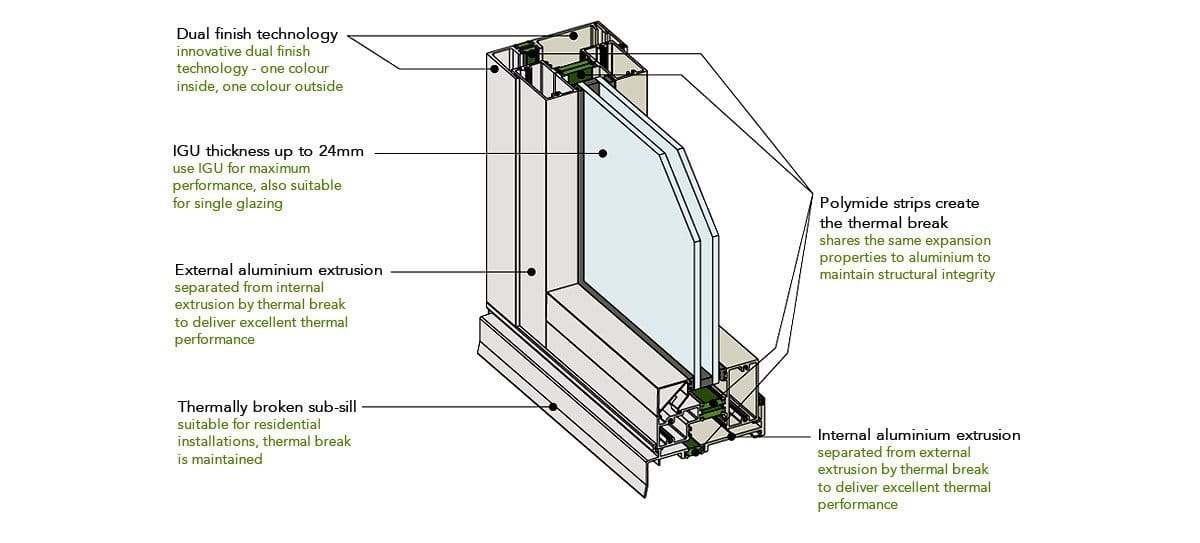
Understanding Glazing and Its Importance
What Is Glazing?
Glazing refers to the glass used in windows, external doors, and skylights of a home. While the term generally refer to the glass component, it often includes the entire assembly, such as frames, tints, and any other elements that impact performance. The glazing in your home can be fixed or operable, allowing for ventilation when needed.
Windows are not only a source of natural light and fresh air but also a major part of a home's thermal performance. By understanding all the aspects of glazing, including glass properties, frames, and furnishings, you can ensure an effective passive design that provides comfort throughout the year.
Why Is Glazing Important?
Glazing affects how much natural light enters your home and how well your interior spaces are connected to the outdoors, providing views and ventilation. Beyond aesthetics, energy-efficient glazing plays a big role in maintaining comfort and reducing energy costs. Poorly designed or inappropriate glazing can lead to unwanted heat gain in the summer, significant heat loss in the winter, and even condensation issues, which can negatively impact indoor air quality.
The efficiency of your home’s heating and cooling systems is closely tied to the quality of glazing. Up to 87% of a home’s heating energy can be gained and up to 40% can be lost through windows. Investing in the right glazing not only increases your home's comfort but also reduces energy consumption, resulting in lower energy bills and reduced greenhouse gas emissions.
Additionally, improved glazing can reduce the peak load on your heating and cooling systems by as much as 30%, saving costs by allowing for a smaller, more efficient air-conditioning unit.
Energy-efficient glazing is not just beneficial for new homes but is also an easy and effective improvement for existing properties. Through renovations, replacing windows or upgrading to better glazing can significantly enhance your home's thermal performance without the need for major structural changes. Furthermore, window furnishings, such as blinds and curtains, can be used to further improve the thermal performance of existing windows, making glazing an adaptable solution for homes of all ages and designs.
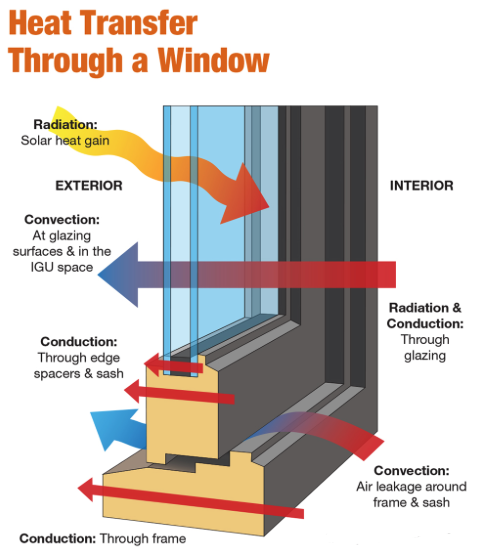
Key Properties of Glass
Understanding the properties of different types of glass is fundamental to making informed glazing choices for your home. These properties affect how well the glazing insulates your home, controls heat gain, and allows natural light in.
Below, we discuss three key properties: Visible Light Transmittance (VLT), conduction (U value), and the Solar Heat Gain Coefficient (SHGC).
Visible Light Transmittance (VLT)
Visible Light Transmittance, or VLT, refers to the amount of natural light that passes through the glazing. This is an important consideration for balancing indoor lighting with energy efficiency.
While a higher VLT allows more light into your home, it may also increase solar heat gain, which can lead to overheating. On the other hand, glazing with too low a VLT may make rooms too dark, leading to increased use of artificial lighting and higher energy costs. Therefore, selecting the appropriate VLT for different areas of your home can help achieve a balance between natural lighting and energy efficiency.
Conduction (U Value)
The U value of a window measures how readily it conducts heat, with lower U values indicating better insulating properties. This means that windows with a lower U value are more effective at keeping your home warm in winter and cool in summer. The U value is expressed as Uw, which describes the conduction of the entire window unit, including both the glass and the frame.
For example, consider a window with a U value of 6.2 W/m² °C (typical for single glazing with aluminium frames). On a cold winter night with a temperature difference of 15°C between the inside and outside, a window with 70m² of glazing area would lose 6,510 watts of heat. If you were to use a double-glazed window with an argon-filled cavity and a U value of 3.1 W/m² °C, the heat loss would be halved to 3,255 watts. This example illustrates how selecting a lower U value can significantly reduce energy loss and improve comfort.
Solar Heat Gain Coefficient (SHGC)
The Solar Heat Gain Coefficient (SHGC) measures how much heat from direct sunlight passes through the entire window (glass and frame). It is expressed as a number between 0 and 1, with lower values indicating that the window transmits less solar heat. The SHGC is important for controlling solar heat gain, especially in hot climates where it is important to limit excessive heat buildup indoors.
The SHGC of a window depends not only on the type of glazing but also on its orientation and the angle of the sun. For example, a window with a perpendicular angle of incidence (i.e., when the sun's rays hit the glass at 90°) will experience the maximum possible solar heat gain. As the angle of incidence increases, more of the sun's radiation is reflected, reducing the amount of heat transmitted through the window. This variability means that both the location of the window and the time of year can impact the actual solar heat gain.
Selecting glazing with the right SHGC for your climate and window orientation can help you achieve the desired balance between warmth in winter and coolness in summer, improving your home's energy efficiency and comfort throughout the year.
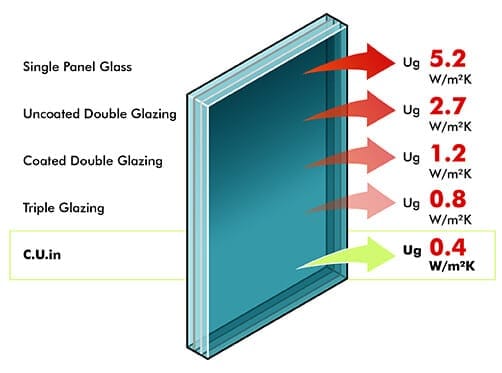
Types of Glazing and Their Applications
Selecting the right type of glazing for your home goes a long way to achieving the desired level of comfort and energy efficiency your after. Different types of glazing are available, each with unique characteristics that affect thermal performance, noise reduction, and safety. Below, we explore the various types of glazing, including single, double, and triple glazing, as well as Low-E glass, tinted, laminated, and toughened glass.
Single, Double, and Triple Glazing
- Single Glazing: Single glazing uses a single pane of glass and is the most basic form of glazing. While it is inexpensive, it offers poor thermal insulation and is not effective at preventing heat loss or gain. Single glazing may be suitable for climates where temperature control is less critical, but it is generally not recommended for achieving high energy efficiency.
- Double Glazing: Double glazing, also known as insulated glass units (IGUs), consists of two layers of glass with a sealed air or gas-filled cavity between them. This cavity acts as an insulator, significantly reducing the amount of heat that is transferred through the window. Double glazing provides improved thermal performance compared to single glazing, making it suitable for most Australian climates.
- Triple Glazing: Triple glazing is similar to double glazing but uses three layers of glass with two cavities. This type of glazing offers even greater insulation and is ideal for homes in cooler climates where minimising heat loss is a priority. However, it is generally more expensive than double glazing and may not be necessary in milder climates.
The performance of double and triple glazing depends on several factors, including the type of glass used, the width of the cavity, and the gas filling the cavity. Commonly used gases include air and inert gases like argon, which provide better insulation. The width of the cavity typically ranges from 6 to 18 mm, with wider cavities offering better insulation.
Low Emissivity (Low-E) Glass
Low-E glass has a special coating that reduces heat transfer through the glass while allowing natural light to pass through. This coating is either pyrolytic (hard) or vacuum-deposited (soft), with each type offering different performance characteristics.
- High Transmission Low-E Glass: This type of Low-E glass allows sunlight to pass through while reducing the amount of heat that escapes, making it ideal for colder climates where solar heat gain is desired.
- Low Transmission Low-E Glass: This type of Low-E glass reduces solar heat gain, making it suitable for hot climates where the aim is to keep the indoor temperature cooler.
Low-E glass can significantly improve both the U value and SHGC of a window, but it must be used correctly to avoid deterioration or under performance. It is more susceptible to surface damage than standard glass, so proper handling and installation are essential.
Tinted, Laminated, and Toughened Glass
- Tinted Glass: Tinted glass contains colour additives that reduce solar heat gain by filtering out infrared light. It is available in colours such as bronze, grey, blue, and green, each with different effects on visible light transmittance and SHGC. Tinted glass is useful for reducing glare and improving privacy while enhancing energy efficiency in hot climates.
- Laminated Glass: Laminated glass consists of two layers of glass with a plastic interlayer that holds the glass together if it breaks. It is commonly used in areas prone to human impact, such as doors and staircases, to enhance safety. Laminated glass also offers some noise reduction and can improve energy efficiency, but it is not a substitute for double glazing.
- Toughened Glass: Toughened glass is heat-treated to make it stronger than standard glass. When it shatters, it breaks into small, less dangerous pieces, making it suitable for areas where safety is a concern, such as bathrooms and bushfire-prone regions. However, toughened glass does not provide better thermal or acoustic performance than other glass types of the same thickness.
Secondary Glazing and Films (Window Tinting)
- Secondary Glazing: Secondary glazing involves adding a second layer of glass or acrylic to an existing window, creating an air gap that improves insulation. While it does not perform as well as a manufactured IGU, secondary glazing is an effective and affordable way to improve the thermal performance of existing windows.
- Window Films: Window films are applied to existing glazing to change its properties, such as reducing solar heat gain or adding privacy. They are a cost-effective solution for improving the performance of windows in hot climates, but they may reduce visible light transmittance and can increase the risk of thermal cracking if not installed properly.
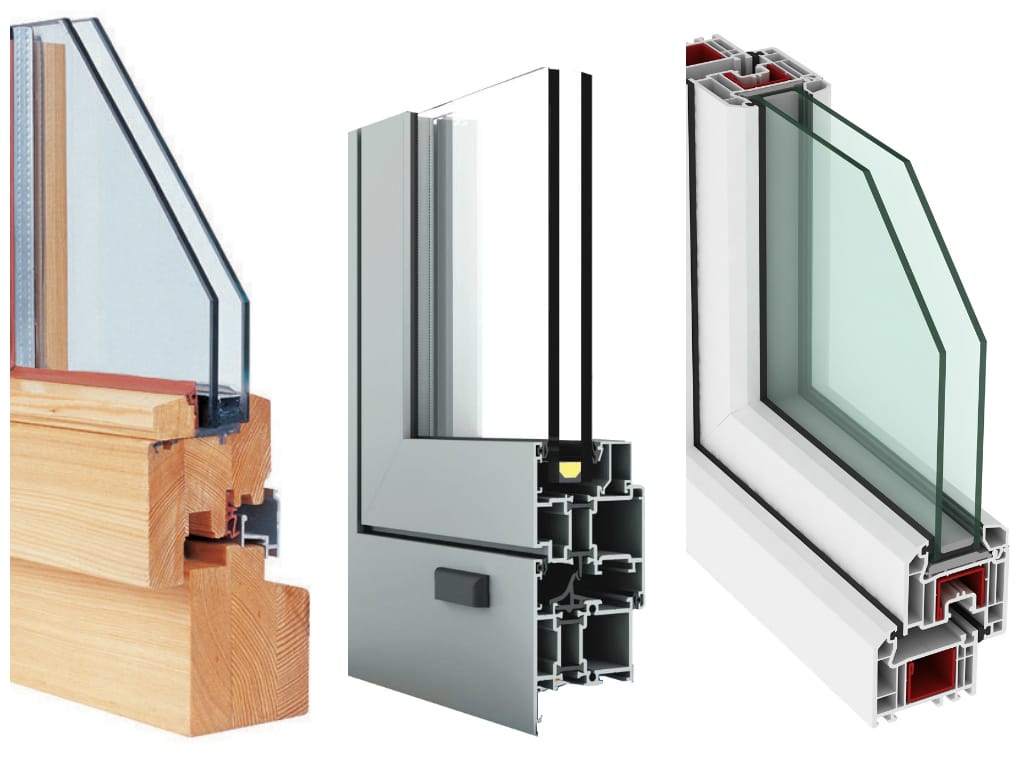
Frame Materials and Their Impact
The choice of window frame is just as important as the glass itself when it comes to improving your home's energy efficiency. Frames can have a big impact on the thermal performance of windows, as energy can be gained or lost through the frame material. In this section, we look at the different types of frame materials commonly used in Australian homes and how they contribute to the overall performance of your glazing.
Aluminium Frames
Aluminium is a popular choice for window frames due to its lightweight, strength, and durability. However, aluminium is a good conductor of heat, which means it can lead to significant energy loss unless additional measures are taken to reduce thermal transfer.
- Thermally Broken Aluminium: Thermally broken frames are made up of two sections of aluminium connected by a structural insulator, such as a low-conductivity polymer. This "breaks" the thermal connection and significantly reduces heat flow through the frame. Thermally broken aluminium frames offer much better performance than standard aluminium and are suitable for use in almost any climate.
Timber Frames
Timber frames are natural insulators and provide good thermal performance, making them an ideal choice for energy-efficient windows. Timber also has a unique aesthetic appeal that complements many architectural styles. However, timber frames require maintenance to protect them from decay and deformation, especially in humid climates.
When choosing timber frames, it is important to select wood from sustainably managed forests or treated timber with high durability. Timber is an organic material that expands and contracts with changes in humidity, so proper weather stripping is essential to prevent air infiltration.
uPVC Frames
uPVC (unplasticised polyvinyl chloride) frames are a type of plastic that offers excellent thermal performance, often outperforming both timber and thermally broken aluminium. uPVC frames are durable, require very little maintenance, and can be moulded into complex profiles to achieve superior air seals.
uPVC frames are increasingly common in Australia due to their energy efficiency and low maintenance requirements. They are a popular choice for home owners looking to enhance both the performance and durability of their windows.
Composite Frames
Composite frames are made by combining two or more materials, typically aluminium with either timber or uPVC. These frames offer the durability and low maintenance of aluminium on the exterior, while providing better thermal performance on the interior. Composite frames are an excellent option for those seeking a balance between performance, aesthetics, and ease of maintenance.
Fibreglass and Other Materials
Fibreglass frames are less common in Australia but offer high strength and good insulation. They are dimensionally stable, meaning they do not expand or contract significantly with changes in temperature. Steel frames are also available, particularly for buildings requiring high fire ratings. Some steel frames are designed for double glazing with thermal breaks, which makes them good insulators.
Frame Styles and Sash Design
In addition to the frame material, the style of window and sash design can influence both the thermal performance and the functionality of the glazing. Different window styles provide varying levels of ventilation, cross-breeze potential, and rain protection.
- Casement Windows: Hinged on the side and opening outward, casement windows can "catch" breezes, making them effective for cross-ventilation. They provide an opening area of up to 95%.
- Awning Windows: Hinged at the top and opening outward, awning windows are good at keeping out rain while allowing ventilation. They open to a maximum of 20-30% and seal well against air leakage.
- Sliding Windows: Sliding windows open to about 45% of the window area and are not as effective at controlling air leakage compared to compression-sealing windows like casements.
- Double Hung Windows: These windows open vertically and provide about 40% of the opening area. While they offer some ventilation, their sealing is less effective than compression-sealed windows.
- Louvre Windows: Louvres can be opened to 90% of the window area, allowing for excellent ventilation. However, they are generally less efficient at sealing against air infiltration unless double-glazed.
The frame material, combined with an appropriate sash design, can have a substantial impact on the overall performance of the window system. Careful consideration of both material and design can help maximise energy efficiency, improve comfort, and reduce long-term energy costs.
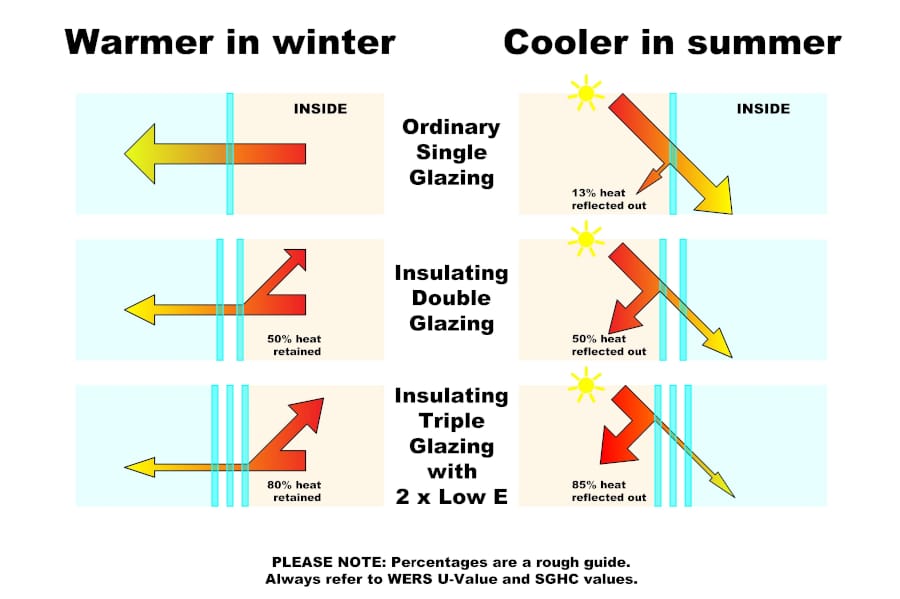
Factors to Consider When Choosing Glazing
Choosing the right glazing for your home involves considering a range of factors that affect its performance, such as the climate you live in, the orientation of the windows, and how glazing integrates with other design elements.
In this section, we look at these factors in detail to help you make the most informed glazing decisions.
Climate Considerations
The climate in which you live plays a major role in determining the type of glazing that will be most effective for your home. Different regions of Australia experience varying temperatures, humidity, and solar exposure, making it essential to tailor glazing choices accordingly.
- Hot Climates: In hot climates such as those in Darwin or northern regions of Queensland, controlling solar heat gain is critical. A low Solar Heat Gain Coefficient (SHGC) is ideal, as it reduces the amount of heat entering your home. Low SHGC values, combined with proper shading devices, can significantly reduce cooling loads.
- Temperate Climates: In temperate regions, like Sydney, Melbourne, and Perth, north-facing windows should have a high SHGC to maximise passive solar gain in winter while being properly shaded in summer. East- and west-facing windows should have shading devices to protect them from direct morning and afternoon sun.
- Cool Climates: In colder climates, such as Canberra or Hobart, a low U value is more important to minimise heat loss in winter. Windows with higher SHGC values can also help by allowing passive solar heat gain, reducing the need for additional heating.
Building Orientation and Passive Design
The orientation of your windows greatly influences the thermal performance of your home. Proper orientation and shading of glazing can help you harness solar energy for passive heating and cooling.
- North-Facing Windows: In Australia, north-facing windows receive the most consistent sunlight throughout the year. To maximise winter heat gain and minimise summer heat gain, north-facing windows should be combined with fixed shading, such as eaves or verandas, which allow sunlight in during winter and block it in summer.
- East- and West-Facing Windows: Windows on the east and west receive low-angle sunlight in the morning and late afternoon, making them prone to overheating. Shading devices like awnings, external blinds, or trees can be used to block this direct sunlight, especially in summer.
- South-Facing Windows: South-facing windows receive minimal solar gain and should be designed with a low U value to minimise heat loss. These windows provide consistent natural light without contributing significantly to heat gain.
Thermal Mass and Glazing Integration
Thermal mass refers to the ability of materials, such as concrete, bricks, or tiles, to store heat. When used in combination with appropriately designed glazing, thermal mass can help regulate indoor temperatures, reducing the need for additional heating or cooling.
- Cool Climates: In cool climates, thermal mass can be used to absorb heat from sunlight during the day and release it slowly at night, providing natural warmth. In these cases, glazing with a high SHGC is ideal to maximise heat gain.
- Hot Climates: In hot climates, thermal mass should be shielded from direct sunlight to avoid it becoming a heat source. Instead, it should be used in combination with glazing and ventilation to absorb excess heat during the day and release it at night, promoting cooling through night purging.
Ensuring the right ratio of glass to thermal mass is crucial. Too much glazing relative to thermal mass can result in overheating, while too little glazing can limit the effectiveness of thermal mass.
Seals and Insulation
The performance of glazing is significantly affected by how well it is sealed. Poor seals allow air infiltration, leading to heat loss in winter and heat gain in summer. It is essential to ensure that both the frames and the areas where the frames meet the walls are well-sealed to maintain energy efficiency.
- Compression-Sealed Windows: Windows like casement and awning styles, which use compression seals, tend to be more effective at preventing air leakage than sliding windows.
- Weather Stripping: Proper weather stripping should be installed to prevent drafts, especially in areas with frequent temperature changes. Using high-quality seals can make a noticeable difference in maintaining a consistent indoor temperature.
- Qlon Seals: One of my favourite specification "hacks" is using qlon seals on all windows. This small rubber strip costs barely any extra per house load of windows and improves energy efficiency and window acoustics.
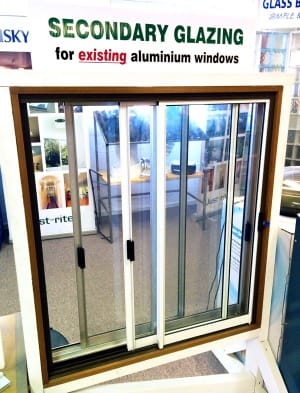
Improving Existing Glazing
If your home already has glazing installed that doesn't meet your performance needs, you don't necessarily have to replace it all. There are several options for improving the thermal performance of existing glazing, which can make a significant difference to your home's comfort and energy efficiency.
In this section, we will explore retrofitting options and the use of window furnishings to enhance the performance of existing windows.
Retrofitting Options
Upgrading your existing windows to improve their energy efficiency is often more cost-effective than replacing them entirely. Below are some effective retrofitting options:
- Secondary Glazing: Secondary glazing involves adding a secondary pane of glass or acrylic inside the existing window frame, creating an insulating air gap. While not as effective as a sealed double-glazed unit, secondary glazing can significantly reduce heat loss and improve noise control, especially if the original windows are single-glazed. This is a practical solution for older homes where window replacement may not be feasible.
- Window Films/Tints: Window films are adhesive layers that can be applied to existing glass to improve its energy performance. Films can reduce solar heat gain by reflecting or absorbing sunlight, making them particularly useful for windows on east- or west-facing elevations. While films are relatively inexpensive and easy to install, they may reduce visible light transmittance, making rooms darker. It’s best to consult a professional installer to avoid issues like thermal cracking of the glass due to excessive heat build up.
- Low-E Coatings: Retrofitting low-emissivity coatings to existing windows can reduce the amount of infrared radiation passing through the glass while maintaining good visible light transmission. These coatings can be applied as a film or as a spray and are ideal for homes looking to reduce heat loss during winter and limit heat gain during summer.
Window Furnishings
Adding window furnishings like blinds, curtains, and pelmets is another great way to improve the overall thermal performance of your glazing. Window furnishings create an additional barrier that helps prevent heat transfer and can be particularly effective at enhancing the performance of existing windows that may not be well insulated.
- Blinds and Curtains: Snug-fitting blinds and curtains can trap a layer of still air next to the window, acting as an insulator and reducing convective heat transfer. The effectiveness of blinds and curtains can be further improved by ensuring there are no gaps at the sides or top where air can move. Curtains with built-in pelmets are particularly useful, as they block drafts and create a more effective insulating layer.
- Honeycomb Blinds: Honeycomb or cellular blinds are designed with multiple layers that form pockets of trapped air. These pockets create an insulating barrier, which helps keep rooms cooler in summer and warmer in winter. Honeycomb blinds are a popular option due to their excellent thermal performance and aesthetic versatility.
- External Shading Devices: External shading, such as awnings, shutters, or pergolas, can prevent sunlight from reaching the window, reducing solar heat gain before it enters your home. This is especially useful for east- and west-facing windows, where the morning and afternoon sun can lead to overheating. Adjustable external shading devices allow you to control the amount of sunlight entering your home throughout the year, maximising comfort and reducing energy use.
Ventilation and Night Insulation
Effective use of glazing to manage heat and comfort also involves considering how you ventilate your home. Natural ventilation through operable windows can help cool your home without relying on air conditioning, while covering windows at night with insulated curtains can help retain heat during colder weather.
- Night Purging: In hot climates, natural ventilation can be used to remove heat that has built up during the day. This process, called night purging, involves opening windows during cooler night time hours to let in fresh air and lower indoor temperatures. Windows with good cross-ventilation potential are especially useful for night purging.
- Insulated Curtains: During the winter, closing insulated curtains at night helps trap heat inside the home, preventing it from escaping through the glazing. Look for curtains made from heavy fabrics or those with a thermal lining for maximum effectiveness.
By upgrading your existing glazing with retrofitting options, window furnishings, and proper ventilation practices, you can improve your home's energy efficiency, comfort, and sustainability without the need for extensive renovations or costly replacements.

Read more about the benefits of good house ventilation here
Quality Management in Glazing Installation
Even the highest-quality glazing can perform poorly if it is not installed correctly. Proper installation is key to ensuring that the glazing provides the intended thermal performance, energy savings, and overall comfort. In this section, we will explore best practices for glazing installation, common installation mistakes, and how to choose the right installer for your project.
Correct Installation Methods
Ensuring that glazing is installed properly is essential for preventing issues such as air leaks, water infiltration, and thermal bridging. Below are some best practices for quality installation:
- Sealing and Insulation: Proper sealing of both the glazing unit and the frame is vital for achieving good thermal performance. Sealants should be applied at all contact points between the frame and the building structure to prevent drafts and moisture penetration. Insulation should also be placed between the frame and the surrounding wall to further enhance the energy efficiency of the window.
- Alignment and Levelling: The window frame should be installed plumb, squarely and level to avoid putting stress on the glass, which can lead to cracks or gaps that reduce efficiency. Proper alignment also ensures that any operable windows open and close smoothly, maintaining a tight seal when shut. Plumb window and door frames also improve security through better lock latching.
For further hardening ideas, check out Youtube and "door security hardening - security proofing doors to your home". There are a few great videos on striker plate hardening and latch hardening (with metal plates. Well worth a look for a cost effective security improvement for your entry doors.
- Minimising Thermal Bridging: Thermal bridging occurs when materials that conduct heat, such as metal frames, create a path for heat transfer, bypassing the insulation. Installing windows with thermally broken frames and using insulation materials around the frame can significantly reduce thermal bridging.
- Weatherproofing: The external parts of the frame must be weatherproofed to prevent water infiltration. Flashings, sill pans, and drip caps are important components that direct water away from the window assembly, protecting both the glazing and the building structure.
Common Installation Mistakes
Poor installation practices can compromise the performance of glazing, leading to energy loss, discomfort, and increased maintenance costs.
Below are some common mistakes to watch out for:
- Inadequate Sealing: Failing to properly seal the frame to the wall or using low-quality sealants can result in air leaks, allowing drafts and reducing the insulating properties of the window. This not only makes your home less comfortable but also increases energy costs.
- Incorrect Frame Installation: If the frame is not installed squarely or level, it can put stress on the glass and lead to cracks or difficulty operating the window. Misaligned frames can also lead to gaps that allow water infiltration and drafts.
- No Allowance for Frame Expansion: Frames, particularly those made of metal or timber, can expand and contract due to changes in temperature and humidity. If no allowance is made for this movement, it can result in stress fractures in the glass or deformation of the frame over time.
- Skipping Insulation Around the Frame: Insulation between the frame and the surrounding wall is often overlooked. This gap, if left uninsulated, can become a significant source of heat loss or gain, undermining the energy efficiency of the glazing unit.

Regulatory Requirements and Ratings
To ensure the optimal performance of your glazing and to comply with local building regulations, it's important to understand the standards and ratings that apply to windows and glazing systems in Australia. These regulations ensure that glazing not only enhances comfort and energy efficiency but also meets structural and safety requirements.
National Construction Code (NCC) and Glazing Standards
The National Construction Code (NCC) sets out the minimum requirements for the design, construction, and performance of buildings, including glazing systems. Glazing in Australia must comply with the NCC's energy efficiency provisions, as well as meet specific standards for structural sufficiency, water penetration resistance, and safety.
- Energy Efficiency Requirements: The NCC includes energy efficiency requirements for glazing, such as the need to achieve a specified U value and Solar Heat Gain Coefficient (SHGC). These requirements vary depending on the climate zone and are intended to minimise energy consumption for heating and cooling.
- AS2047 Compliance: All windows and glazed doors installed in Australian buildings must comply with Australian Standard AS2047. This standard outlines the requirements for structural sufficiency, resistance to wind loads, and water penetration. It ensures that windows are designed and installed to withstand Australia's diverse weather conditions.
- Safety Glazing: The NCC also mandates the use of safety glazing in certain areas, such as windows that are close to the floor or in doors, to reduce the risk of injury if the glass breaks. Safety glazing includes toughened or laminated glass that breaks in a way that reduces the potential for harm.
Window Energy Rating Scheme (WERS)
The Window Energy Rating Scheme (WERS) is an important resource for comparing the energy performance of different glazing systems. WERS provides a star rating for windows and doors based on their heating and cooling performance, making it easy to choose the best option for your needs.
- U Value and SHGC Ratings: WERS ratings provide detailed information about the U value and SHGC of each window or door system. The U value indicates how well the window insulates against heat transfer, while the SHGC measures how much solar heat enters the home. By understanding these ratings, you can choose glazing that is suited to your climate and desired level of energy efficiency.
- Visible Light Transmittance (VLT): WERS also provides information on Visible Light Transmittance (VLT), which is the amount of natural light that passes through the glazing. Choosing a glazing system with an appropriate VLT can help you balance natural lighting and reduce reliance on artificial lighting, further improving energy efficiency.
BASIX and Local Requirements
In addition to the NCC, individual states and territories may have specific requirements related to glazing. For example, in New South Wales, the Building Sustainability Index (BASIX) requires homeowners to achieve specific energy and water efficiency targets, which include considerations for glazing.
- BASIX Requirements: BASIX assesses the performance of a home based on its design, including the efficiency of its glazing. It uses tools like the BASIX DIY tool or other accredited energy rating software to determine whether the proposed glazing meets the required standards for energy efficiency.
- Northern Territory Regulations: In the Northern Territory, additional requirements such as a compliant glazing calculator certificate may be needed to demonstrate that the glazing meets energy efficiency and structural standards. These regional variations emphasise the importance of understanding local regulations when planning your glazing.
Passive House Certification
For those interested in building to the Passive House standard, glazing requirements are more stringent than the NCC. Passive House is an international standard focused on achieving a high level of energy efficiency and thermal comfort through rigorous design and construction practices.
- Glazing Requirements: To meet Passive House standards, windows and glazed doors must have low U values, high airtightness, and excellent performance in both insulating and minimising heat gain. Only specific high-performance glazing products meet the requirements for Passive House certification, making it essential to select certified products if you are pursuing this standard.

Air Sealing goes a long way to meeting passive house design standards
Documentation and Specification
Proper specification and documentation are required for ensuring that the glazing installed in your home meets regulatory and performance requirements. Without clear specifications, there is a risk of using products that do not meet energy or safety standards, which could lead to costly errors or non-compliance.
- Detailed Specifications: When planning your glazing, ensure that the following details are included in your building plans:
- Dimensions: Height and width of the window or door, along with head and sill heights.
- U Value and SHGC: The required U value and SHGC, as specified by the NCC or BASIX.
- WERS Rating: The Window Energy Rating Scheme rating for the glazing system.
- Opening Types: Details about the type of window or door (e.g., casement, sliding) and how it will be operated.
- Safety Requirements: Compliance with AS2047 for structural sufficiency and AS1288 for safety glazing.
Ensuring that these specifications are clearly documented will help avoid any confusion during the construction process and ensure that the glazing installed in your home meets all required standards for performance, safety, and energy efficiency.
Quality Checklist for Home owners
Choosing and installing the right glazing for your home is a significant investment that impacts energy efficiency, comfort, and safety. To ensure you get the best performance from your glazing, it's essential to have a quality checklist to guide your decision-making process and monitor the installation. In this section, we provide a comprehensive checklist for both selecting and installing glazing, helping you avoid common pitfalls and ensure the best outcome.

Read more about how the wind rating SHOULD BE calculated
Checklist for Choosing the Right Glazing
- Understand Your Climate and Requirements:
- Determine which climate zone you are in and consider how it affects your glazing choices.
- Determine the wind rating and terrain category for your home site.
- Decide whether you need to prioritise insulation (U value) or solar heat control (SHGC).
- Evaluate Glazing Types:
- Compare different types of glazing, such as single, double, or triple glazing, and choose based on your energy performance goals.
- Consider the benefits of Low-E glass if reducing heat loss is a priority.
- Assess Frame Materials:
- Consider the pros and cons of frame materials such as aluminium, thermally broken aluminium, timber, uPVC, and composite frames.
- Ensure that the frame you select has good insulating properties and suits the architectural style of your home.
- Review Ratings and Compliance:
- Check the Window Energy Rating Scheme (WERS) ratings to compare the U value, SHGC, and Visible Light Transmittance (VLT) of different glazing systems.
- Ensure the glazing meets National Construction Code (NCC) requirements and complies with AS2047 and AS1288 standards.
- Consider Shading and Ventilation:
- Plan for shading devices, such as eaves or awnings, particularly for east- and west-facing windows.
- Ensure that operable windows are well-positioned to maximise natural ventilation and promote passive cooling.
- Choose a Reputable Supplier and Installer:
- Select a supplier and installer that are accredited by the Australian Glass and Window Association (AGWA) or other relevant bodies.
- Look for reviews, references, and past projects to assess their reliability and quality of work.
- Check Glazing Specifications:
- Verify that the glazing specifications, such as dimensions, U value, SHGC, and WERS rating, are clearly documented in your building plans.
- Confirm that any safety requirements, such as the use of safety glass in specific locations, are met.
Installation Quality Control Checklist
- Inspect Frame Alignment and Sealing:
- Ensure that the window frame is properly aligned, level, and square to prevent stress on the glass and ensure smooth operation.
- Check that all contact points between the frame and wall are properly sealed to prevent air and moisture infiltration.
- Verify Thermal Breaks:
- If using thermally broken frames, ensure that the insulating barrier is correctly installed to reduce thermal bridging.
- Confirm that insulation is installed around the frame to enhance the overall energy efficiency of the window.
- Monitor Weatherproofing Measures:
- Make sure that external weatherproofing components, such as flashings and sill pans, are installed to direct water away from the glazing assembly.
- Verify that the glazing is installed with adequate drainage to prevent water buildup and ensure long-term durability.
- Check Window Operation and Compression Seals:
- Test all operable windows to ensure they open and close smoothly, with compression seals effectively preventing drafts.
- For sliding windows, check that the seals are intact and provide a tight fit to minimise air leakage.
- Inspect Safety Compliance:
- Confirm that safety glass, such as toughened or laminated glass, is installed in locations required by the NCC, such as windows near the floor or in doors.
- Ensure that openable windows meet fall prevention requirements, with limiters or reinforced screens in place where necessary.
- Final Performance Evaluation:
- Perform a thorough inspection for any visible gaps, cracks, or condensation between glass panes that may indicate a failure in sealing.
- Evaluate the thermal comfort in rooms with new glazing to confirm that there are no drafts and that temperatures are maintained as expected.
- Documentation and Handover:
- Request a final inspection report from the installer, outlining the completed work and confirming compliance with relevant standards.
- Keep all product information, ratings, and warranties for future reference.
Conclusion
Choosing the right glazing for your new home is one of the most effective ways to enhance comfort, reduce energy costs, and increase the overall efficiency of your living space.
Understanding the types of glass, frame materials, and their impact on performance will help you make informed decisions that align with your climate, design, and energy goals.
From selecting energy-efficient glazing options like double or triple glazing and Low-E glass to ensuring proper installation and considering retrofitting solutions, the choices you make can significantly improve your home's thermal performance and sustainability. By taking into account factors such as climate, building orientation, and quality management throughout the selection and installation process, you can create a home that is not only beautiful but also efficient and comfortable throughout the year.
Remember, glazing is more than just a window to the outside—it plays an important role in maintaining a comfortable and cost-effective home environment.
FAQ Section
- How does double glazing improve the energy efficiency of a home?
- Double glazing uses two layers of glass with an air or gas-filled cavity between them, acting as an insulator. This design significantly reduces heat transfer, keeping your home warmer in winter and cooler in summer, which helps lower energy bills.
- What are the benefits of Low-E glass?
- Low-E (low emissivity) glass has a special coating that reduces the amount of heat that passes through the glass while still allowing natural light in. It helps keep your home cooler in summer and warmer in winter, improving energy efficiency without compromising on daylight.
- Can I retrofit my existing windows with better glazing?
- Yes, you can improve existing windows by adding secondary glazing, applying Low-E films, or using window furnishings like curtains and blinds. Secondary glazing and window films are cost-effective ways to enhance thermal performance without replacing the entire window.
- What are the differences between timber and aluminium frames?
- Timber frames are natural insulators and provide better thermal performance, while aluminium frames are strong and low maintenance but can conduct heat unless they are thermally broken. Your choice will depend on your energy efficiency goals, aesthetic preference, and maintenance requirements.
- What is the Solar Heat Gain Coefficient (SHGC), and why is it important?
- The SHGC measures how much heat from sunlight passes through a window. A lower SHGC reduces heat gain, which is important in hot climates, while a higher SHGC allows more heat in, beneficial in cooler climates. Choosing the right SHGC helps balance warmth and cooling needs.
- Which type of glazing is best for a hot climate like Northern Australia?
- In hot climates, glazing with a low SHGC is ideal to minimise heat gain. Double glazing or Low-E glass combined with effective shading can significantly reduce cooling costs and improve indoor comfort.
- How do I know if my windows are installed properly?
- Properly installed windows should be level, well-sealed, and free of drafts. There should be no gaps between the frame and the wall, and operable windows should open and close smoothly. A final inspection by a qualified installer can confirm proper installation.
- Can glazing reduce outside noise?
- Yes, double glazing and laminated glass are effective at reducing noise, especially high-frequency sounds like voices. For better noise control, thicker or laminated glass with a large air gap is recommended, which can help reduce traffic or aircraft noise.
- How can window furnishings improve energy efficiency?
- Window furnishings such as curtains, blinds, and pelmets create an additional insulating barrier, reducing heat transfer through windows. Properly fitted curtains with pelmets can trap still air and minimise drafts, improving the thermal performance of your windows.
- Are thermally broken frames worth the extra cost?
- Thermally broken frames have a built-in insulator that reduces heat transfer, making them more energy-efficient than standard aluminium frames. While they may cost more upfront, the improved thermal performance can result in lower heating and cooling costs, making them a worthwhile investment.
Further Reading

